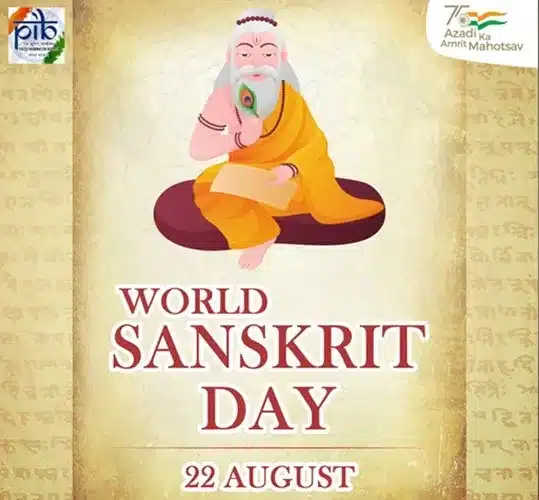Sanskrit Diwas: The day is marked to promote Sanskrit, one of the oldest languages | PIB India
Today, on the Shravana Poornima, is observed as World Sanskrit Day. The day is also stated as Sanskrit Diwas or Vishva-samskrita-dinam (विश्वसंस्कृतदिनम्). It is an annual event focused around the ancient Indian language of Sanskrit that incorporates lectures about the language and is aimed to promote its revival and maintenance.
On the same day, Raksha Bandhan, a popular, traditionally Hindu, annual rite, or ceremony, which is central to a festival of the same name celebrated in South Asia, and in other parts of the world significantly influenced by Hindu culture. On this day, sisters of all ages tie a talisman, or amulet, called the rakhi, around the wrists of their brothers, symbolically protecting them, the festival of Raksha Bandhan is observed with great pomp and show among the members of the Hindu community especially in India. World Sanskrit Day is celebrated on Shraavana Poornima, which is the full moon day of the Shraavana month in the Hindu calendar. The Sanskrit organization Samskrita Bharati is involved in promoting the day. In the year 2021, this day is celebrated on August 22.
The Prime Minister, Shri Narendra Modi has extended his wishes on the occasion of World Sanskrit Day and shared his greetings with the people in Sanskrit.
In a tweet, the Prime Minister said;
एषा भाषा प्राचीना चेदपि आधुनिकी,
यस्यां गहनं तत्त्वज्ञानम् अस्ति तरुणं काव्यम् अपि अस्ति,
या सरलतया अभ्यासयोग्या परं श्रेष्ठदर्शनयुक्ता च,
तां संस्कृतभाषाम् अधिकाधिकं जनाः पठेयुः।
सर्वेभ्यः संस्कृतदिवसस्य शुभाशयाः।— Narendra Modi (@narendramodi) August 22, 2021
History of Sanskrit Langauge
Sanskrit (संस्कृत) is a classical language of South Asia belonging to the Indo-Aryan branch of the Indo-European languages. It arose in South Asia after its predecessor languages had diffused there from the northwest in the late Bronze Age. It is the sacred language of Hinduism, the language of classical Hindu philosophy, and of historical texts of Buddhism and Jainism. It was a link language in ancient and medieval South Asia, and upon transmission of Hindu and Buddhist culture to Southeast Asia, East Asia, and Central Asia in the early medieval era, it became a language of religion and high culture, and of the political elites in some of these regions.
Sanskrit is similar to several Old Indo-Aryan language varieties. The most archaic of these is Vedic Sanskrit found in the Rig Veda, a collection of 1,028 hymns composed between 1500 BCE and 1200 BCE by Indo-Aryan tribes migrating east from what today is Afghanistan across northern Pakistan and into northern India. The greatest dramatist in Sanskrit, Kālidāsa, wrote in classical Sanskrit, and the foundations of modern arithmetic were first described in classical Sanskrit. The two major Sanskrit epics, the Mahābhārata and the Rāmāyaṇa, however, were composed in a range of oral storytelling registers called Epic Sanskrit which was used in northern India between 400 BCE and 300 CE, and roughly contemporary with classical Sanskrit.
Sanskrit’s status, function, and place in India’s cultural heritage are recognized by its inclusion in the Constitution of India’s Eighth Schedule languages. However, despite attempts at revival, there are no first-language speakers of Sanskrit in India. Sanskrit has been taught in traditional gurukuls since ancient times; it is widely taught today at the secondary school level. The oldest Sanskrit college is the Benares Sanskrit College founded in 1791 during East India Company rule. Sanskrit continues to be widely used as a ceremonial and ritual language in Hindu and Buddhist hymns and chants and in South Indian classical music. There are 50 letters in Sanskrit – the first 16 are vowels and next 34 are consonants.
History of World Sanskrit Day
The Observation of the day initiated in 1969 with the aim of enlightening the next generation about the ancient Indian language, the Government of India decided to celebrate Sanskrit Diwas on the auspicious occasion of Raksha Bandhan. Sanskrit is believed to be an Indo-Aryan language, which is said to have originated around 3500 years ago. However, in the scriptures, the Sanskrit language is thought to have originated in the second millennium BCE, when the Rig Veda was composed.
Nowadays Sanskrit Day is celebrated with great enthusiasm, not only in India but also worldwide. The contribution of the Central and State Government of India is also noteworthy in this. The week in which Sanskrit day falls is celebrated as Sanskrit week for some years. Due to the declaration of Sanskrit as the official language in Uttarakhand, there are different programs and competitions in the Sanskrit language every day in Sanskrit week. The basic objective of celebrating Sanskrit Day and Sanskrit Week is to spread the word of the Sanskrit language.
The language impressed numerous westerners because of its obvious reasons of being succinct in nature. Sir William Jones, an English scholar, arrived in India in 1783 as a judge of the British Supreme Court in Calcutta. He was the Asian Society’s founder. He translated the Sanskrit author Kalidasa’s Abhijnana Shakuntala and Ritu Samhara as well as Jayadeva’s Gita Govinda into English. Manusmriti was also translated into English by Jones.

